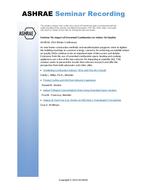This paper reports the relative energy consumption of prototype VAV and CAV air-conditioning systems under various load conditions simulating those of a typical office building in humid tropical climates such as Singapore’s. Tests were conducted inside two adjoining environmental chambers where space loading was varied from 0.217 to 0.295 kW/m2 (68.81 to 93.54 Btu/h ft2) with corresponding sensible heat ratio (SHR) ranging from 0.65 to 0.9. The VAV system consistently consumed less energy compared to the CAV system under constant as well as variable load conditions. The percentage energy saving ranged from 21.97% at 0.217 kW/m2 (68.81 Btu/h ft2) to 12.42% at 0.295 kW/m2 (93.54 Btu/h ft2) under constant loading, and it decreased with increased space loading. The experiments measured moderate energy savings under the experimental conditions that are assumed to be the typical load condition in Singapore. Because the implementation costs are significant, it appears that a VAV system has marginal economic benefit in Singapore.
Units: Dual
Citation: ASHRAE Transactions, vol. 111, pt. 1, Orlando 2005
Product Details
- Published:
- 2005
- Number of Pages:
- 8
- File Size:
- 1 file , 1.7 MB
- Product Code(s):
- D-25688


